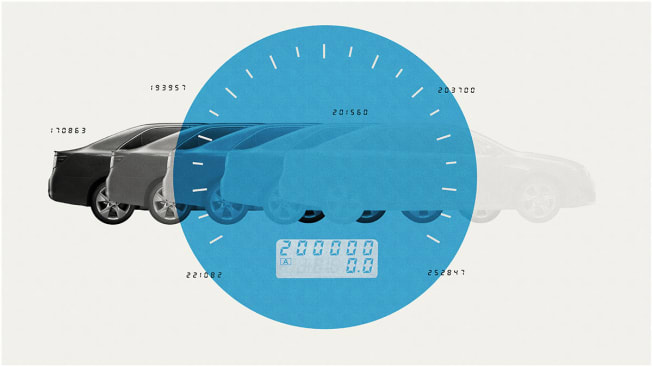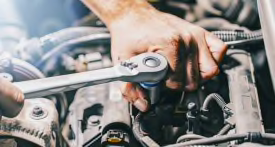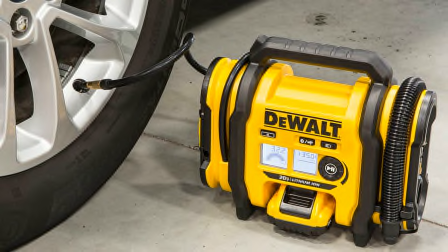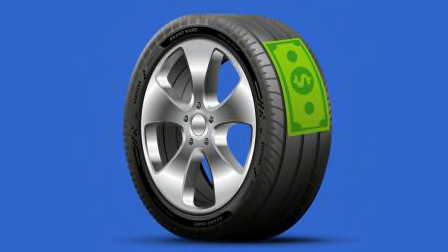How to Make Your Car Last 200,000 Miles and More
Holding on to your vehicle for as long as possible is often the best way to save money

Getting your money’s worth out of a car means holding on to it—ideally, for at least several years beyond its warranty period. By then, the car depreciates more slowly, and even as maintenance and repairs get more expensive, your overall ownership costs dwindle. In fact, Consumer Reports’ experts find that the true financial win is if you can stretch ownership all the way to 200,000 miles.
To get there, it’s helpful to start with a car known for above-average reliability, built by a brand with lower-than-average maintenance and repair costs. From that promising foundation, the formula is simple: Treat the car like you want it to last. More specifically: Open the owner’s manual to the section with the car’s lifetime service schedule and follow it to the letter.
Cars for the Long Haul
The Road to 200,000 Miles
To help your money-saving journey to the 200,000-mile club, our experts have mapped out what you need to do to get there. We’ve used a 2023 Toyota RAV4 as an example—the bestselling vehicle in America and popular among Consumer Reports members—but the checklist will be similar for most vehicles.
Our guide focused on a used model rather than a 2025 RAV4 to ensure that pricing was available for its services. (The 2023 and 2025 RAV4 are the same design.) Our mechanics itemized the work needed at major mileage intervals. The Car Repair Assistant, available at CR.org/repair, provided the price estimates, which factor in parts and labor for the Yonkers, N.Y., area—home of Consumer Reports’ headquarters. Prices may vary significantly based on the vehicle, how it’s equipped, your location, and the shop you use. In addition, tariffs may raise the cost of imported parts.
In most cases, an independent repair shop will be less expensive than a dealership for service. In addition, Consumer Reports members who go to independent mechanics and several of the chain repair shops (AAA Car Care Plus and Goodyear Auto Service among them) report having a more satisfying experience and being more likely to get a discount than those who go to dealerships for service. Our survey also found that independent repair shops were the most likely to negotiate on price. If you use a chain shop or dealership for repairs, check its website for discounts or special promotions sent via email if you’ve been a customer there before.
Ultimately, you want to find a shop that you can trust and stick with it. For many owners, that may mean using the dealership during the warranty period, then transitioning to a local independent shop once the warranty expires.
Wherever you have service done, to get to 200,000 miles, the major milestones listed below will help you prepare for the service and budget accordingly.
0 to 36,000 Miles
During this traditional warranty period, maintenance will be limited to regular oil changes, tire rotations, and inspecting the brakes, wipers, and tires for wear. You can save money by replacing simple items yourself, such as wiper blades and the cabin air filter, which is less complicated than it sounds. Some parts stores will even install the blades for free. Beyond those worn items, the vehicle’s various parts and systems will be under warranty, so you can go to the dealership for repairs. Some automakers, such as Honda, Nissan, and Toyota, include limited free maintenance for the first years of ownership.
Oil change and tire rotation: $179-$227, every 10,000 miles
Windshield wiper blades: $109-$123, every 6 months
36,000 to 60,000 Miles
By now, you probably need new tires, but don’t just buy new versions of the set that came with the car. Consult Consumer Reports’ tire ratings, which factor in overall performance, predicted treadwear, and purchase price. Each CR Recommended tire excels for grip, comfort, noise, treadwear, and snow traction, when applicable. When you’ve decided on a set, check the manufacturer’s website. Most times, you can find rebates, often around $100 off per set. Your brake pads and possibly the rotors could be nearing the end of their service life, too. Have a mechanic check them and, if necessary, replace them. Even if only one brake needs replacing immediately, save yourself time and money by having the other side replaced as well. After any tire replacement or other serious work to the wheels, make sure your mechanic does a four-wheel alignment.
Battery: $270
Tires: $760*
Wheel alignment (four wheels, with ADAS calibration): $329-$420
Brake pads and rotors (pair, front): $570-$661
60,000 to 100,000 Miles
Most vehicles are 5 or more years old and out of warranty at this point. Continue to monitor brakes and tires for wear, and have your mechanic pay closer attention to suspension parts, such as shock absorbers, struts, and bushings. Like brakes, it’s best to replace suspension parts in pairs. Meanwhile, remain faithful with oil and filter changes, and tire rotations. You may also need a new set of tires. Again, whenever you buy new tires or have suspension parts replaced, be sure your mechanic finishes with a four-wheel alignment.
Front struts (both): $1,219-$1,410
Rear struts (both): $692-$846
Control arms (both front): $667-$812
Brake pads and rotors (pair, rear): $559-$708
100,000 to 150,000 Miles
Major services, such as timing-belt replacement, are typically needed during this period. (Most recent cars, including the RAV4, use a durable timing chain, which should last the lifetime of the vehicle and not need to be replaced.) Plan to replace items such as spark plugs, starter, alternator, and suspension parts. Collectively, these costs can be significant, but you should only have to do them once. “In theory, if you get that stuff replaced in the 100,000-to-150,000-mile range, the cycle starts again and you should be good for a long time,” Ibbotson says.
Tires: $760*
Water pump assembly: $773
Spark plugs: $236-$281
Alternator: $558-$594
150,000 to 200,000 Miles
This is when your car may need more significant repairs, such as the replacement of leaking engine oil seals, a transmission rebuild or replacement, a new exhaust system, or possibly a head gasket replacement. “The potential for big repairs goes up after 150,000 miles,” Ibbotson says. But if you started with a car known for reliability, major problems should be rare.
Tires: $760*
Head gasket: $4,503-$5,538**
Transmission replacement: $7,927-$8,567
Muffler replacement: $737-$786
*Prices are from Tire Rack and CR experts.
**Prices are for a 2023 Toyota RAV4 (except for the head gasket, which is for a 2021 RAV4) based on parts and labor pricing in the Yonkers, N.Y., area collected using the Car Repair Estimator (CR.org/carrepair) powered by RepairPal.
How to Join the 200K Club
The first rule of getting a car to 200,000 miles (and beyond) is to follow a maintenance plan. That’s why automakers include a schedule in the owner’s manual for every car they sell. Taking care of basics, such as timely oil changes and checkups, can help you address small problems before they become bigger, more expensive ones. Proactive repairs can save money and avoid the inconvenience of a breakdown.
It also helps to keep the car clean, inside and out. Routine car care in the form of car washes, waxing, and vacuuming helps prevent pain damage and foul smells. It also gives you an opportunity to give the car an inspection that may identify potential problems early.
“Taking care of a car is much more than oil changes,” Ibbotson says. “Everything is connected, so when one part fails, it can put more strain on others, causing them to fail, too,” Ibbotson says.
Oil Changes
Changing and topping off engine oil and transmission fluid—and differential oil for all-wheel-drive and four-wheel-drive vehicles—are the bedrock of auto maintenance. Check the manual for specific recommendations. When selecting which fluids to use for replacement, follow the owner’s manual’s recommendations.
How often: Every 3,000 to 10,000 miles, depending on the model. Your best bet is to follow the maintenance schedule recommended by the manufacturer in the owner’s manual. Ibbotson says that if your car is older, you might consider following the “severe duty” schedule, which calls for more frequent service.
Where to go: A repair shop you trust. Avoid chain establishments because they might use inexpensive oil and filters. Some newer cars call for rather specialized oils that a chain may not carry.
Smart tip: Don’t splurge on synthetic oil unless the manual specifically requires it.
Tire Replacement
Start shopping for replacement tires when the tread is worn down to 4/32 of an inch, or when they’re approaching 10 years old. Rough roads and worn suspension parts on the car can cause tires to wear faster.
How often: Tires can last from 30,000 to 80,000 miles, depending on your car, the tire model, and your driving.
Where to go: Your usual trusted repair shop or a specialty tire shop.
Smart tip: Properly inflated tires are safer and save gas. Check the doorjamb sticker for the proper pressure. It’s also important to rotate tires every 5,000 to 8,000 miles to promote even wear. Tire shops often include perks, such as free rotations, that can save money over time. And it’s common for tire manufacturers to offer coupons on their websites for replacing a full set.
Brakes
Brakes are, by definition, a wear item: The pad material wears away from use and will need to be replaced periodically. They won’t last as long under frequent stop-and-go conditions or repeated hard braking. City driving tends to be harsher on the brakes than highway cruising.
How often: 25,000 to 70,000 miles.
Where to go: A repair shop you trust.
Smart tip: Driving smoothly extends brake life and saves gas. Also, spend more for high-quality brake parts. Inexpensive pads tend to wear quicker, and inexpensive rotors typically have less protection against corrosion, and they can more easily warp and cause vibration when you’re driving. Our mechanics recommend also replacing the rotors whenever pads are replaced.
Spark Plugs
Ibbotson says spark plugs and other tuneup items aren’t a problem on most cars until the 100,000-mile mark. Make sure to get the exact type recommended by the manufacturer. The wrong plugs can wreck fuel economy and even cause engine damage.
How often: Usually every 100,000 miles.
Where to go: A repair shop you trust and is experienced with your make and model. This job can require extensive work that benefits from brand-specific expertise.
Smart tip: When changing spark plugs, make sure the replacements are equivalent in quality to what came with the car to ensure proper performance. Your mechanic can advise you.
Timing Belt
Timing belts have become less common in newer cars, but for those vehicles that have them, follow manufacturer recommendations on replacement. The service can be expensive due to the amount of labor needed and also because it’s typically related to other repairs. Skipping this important service item can result in major engine damage if a worn belt breaks.
How often: Usually every 60,000 to 100,000 miles.
Where to go: A repair shop you trust.
Smart tip: It may make sense to also replace the water pump, belt tensioners, and pulleys at the same time to save on future labor costs.
Shocks/Struts
Shock absorbers and struts soak up road bumps and keep the car steady. Like brakes and tires, the lifespan of these suspension parts can depend on the quality of the roads where you drive.
How often: Shocks and struts can last 80,000 miles or more, but rough roads and aggressive driving can make them wear out faster.
Where to go: A repair shop you trust.
Smart tip: High-quality parts will last longer than inexpensive ones. Be sure the shocks and struts you use meet manufacturer specifications. And be aware that cars with adaptive suspension components—usually luxury or performance cars—can make this kind of service more expensive.
Battery
How often: Most batteries last from three to five years. Hot weather and letting the car sit for extended periods can shorten the battery’s life. Absorbent Glass Mat (AGM) batteries are better able to handle the demands of modern cars than traditional lead-acid batteries, but they’re often more expensive. Even electric cars have a 12-volt battery that needs to be periodically replaced.
Where to go: An auto parts store (many install batteries free of charge) or a repair shop you trust. Check Consumer Reports’ car battery ratings.
Smart tip: Inspect your car battery periodically. If you see corrosion on the terminals or it looks like it’s leaking, it’s time to replace it.
Exhaust System/Muffler
Most cars come with a stainless steel exhaust system that lasts a long time. When it does wear out, it’s probably at high mileage.
How often: When rust holes perforate the pipes or mufflers.
Where to go: A dependable shop that specializes in replacing exhaust systems and mufflers.
Smart tip: Use quality exhaust parts. Inexpensive ones are more likely to corrode, so you’ll have to pay labor costs for a replacement sooner.
The End of the Road
No matter how well you choose and care for a car, someday it will be time to move on because it’s costing too much or is no longer safe. Still, saying goodbye can be a tough decision, especially if you’re attached to your car.
Here are signs that it’s probably time to find another vehicle:
• It needs a big repair that will cost more to fix than the car is worth.
• Rust is compromising the structural integrity.
• It remains unreliable even with frequent repairs.
• It has been in a flood or serious accident.
• You’ve had the vehicle for 150,000-plus miles and your needs have changed. In that time the state-of-the-art for safety has improved, as has connectivity and entertainment. If you can afford a new(er) car, there are definite benefits.
Editor’s Note: This article has been updated since it originally appeared in the May 2022 issue of Consumer Reports magazine.





















